#well of sorrows
Note
The Well of Sorrows has always been interesting to me. What do you think would be the romance options reactions to a non elven inquisitor speaking elvhen in their sleep after drinking from the Well?
Cassandra: This is...unsettling.
Of course, she has been unsettled about this since they left the Temple. No matter her misgivings, the Seeker can only hold them closer and vow -to them and to herself- that she will be at their side as long as they can when the price of their action is finally due.
Blackwall: Maker's Breathe, that's...a bad sign. He won't blame them for the decisions made with the inquisition in mind, but even in the horse warmth of the stables the would be warden feels a chill. He can't claim to know what is coming of all this, but he doesn't intend to let them face it alone.
In peace, vigilance. It will be his watchword.
Dorian: Given that in the course of their relationship thus far his amatus has shown no keen understanding of that ancient tongue, Skyhold's resident necromancer is understandably unnerved by the development. Unnerved enough to set wards about his person, should his lover awaken with someone else nehind the eyes he has come to love.
In the daylight hours he focuses his already keen mind to a razer point, hunting for anything that might shed more light on the gaes they are under-- and how to remove it without even greater toll.
iron Bull: Demon ancient elven god crap. The Qun might be broadly considered a religion, but the mercenary captain has never taken much truck with the divine of any race. To have tangible evidence that someone besides him has taken residence within his Kadan is infuriating and terrifying.
Truncated sleep will become the norm, as the inquisitor is shaken awake each time those nightly monologues take form, until they can work out something that settles them both. In the interim he will be sending letters out to every contact he still has, trying to learn more about what they will be facing.
Sera: Nope, nope, nope. She has never tolerated elfy shite and Red Jenny doesn't mean to start now! They are beating this out right quick, no matter how many times it takes. She wants her honeykiss back, now.
Cullen: Unnerving as it might be, he has spoken as bad or worse in his time-- and sleep has not always been his companion. He will guard her, as much as he can, and what he lacks in understanding of this strange deal with the well of sorrows he will simply compensate by being ever at her side.
Josephine: For the moment, until her letters to scholars and Keepers and anyone else who might help comes back, Skyhold's ambassador simply holds them close and painstakingly writes down (phonetically) everything they say. She might not know what they are murmuring in their slumber, but someone will.
Knowledge is the only power she has, but no one has ever accused Josephine Montiliyet of not knowing how to wield what she has in hand. They will yet come to the end of this puzzle together.
Mod Fereldone
55 notes
·
View notes
Text
The conversation :
Me: It's funny how my Dalish Elven Mage Lavellan just stands around while Morrigan boasts that she's the best candidate to drink at the well of sorrows despite being a First to the Keeper of the clan whose duty is to preserve and reclaim the heritage of her people. I wish there were additional lines to call that out or even contest her knowledge.
Some rando: But Morrigan is the most qualified to drink at the well because she was trained by Mythal herself and she had a lot of experience with eluvian, the Crossroads, the 5th blight etc... Meanwhile the Dalish got all their history wrong and what they got are just erroneous stories and legends and propaganda by the elvenhen. Maybe you should play the Trespasser to know more about it.
What it looks like in my head:
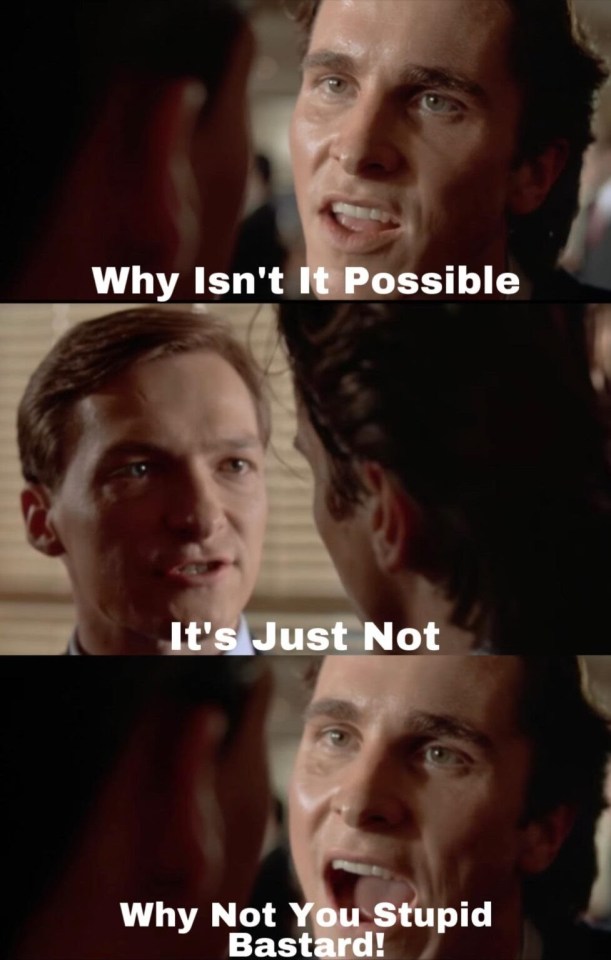
I'm actually now pissed at how BioWare had written the Dalish. From a clan of nomads who are trying to uphold whatever is left to their heritage after being enslaved by humans to some LARPers who like to pretend that they're the true elves but are originally slaves by the elven gods. Now some human apostate and an egghead now hold the "true" heritage of the elves and those who are affected by it have no right to to question it or reclaim the lost artefacts for themselves because the game deems that those two people to be in the right.
I'm all for narratives twists. But this twist really leaves a bad taste in my mouth. Especially when you can't react towards a world shattering revelation and you're forced to to believe what a separate third party says about your history instead of discovering it for yourself.
#bioware critical#Dragon age inquisition#Dragon age#lavellan#morrigan#dalish#what pride had wrought#well of sorrows
128 notes
·
View notes
Photo
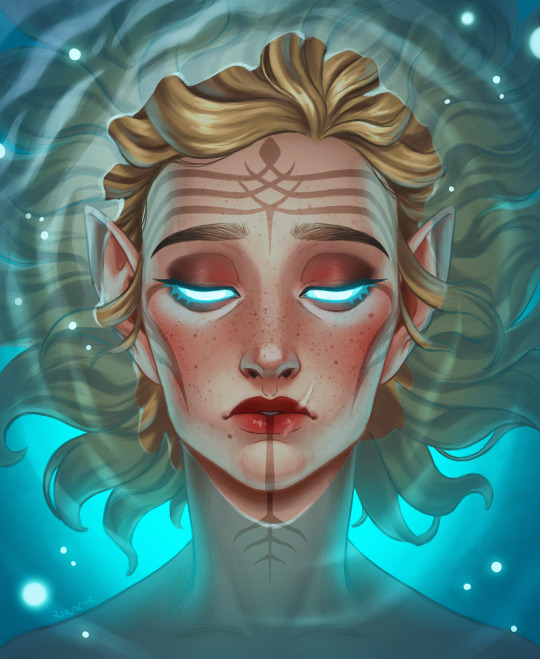
Vir'abelasan
#dragon age#dragonage#dragon age fanart#dai#lavellan#inquisitor lavellan#well of sorrows#dai fanart#artists on tumblr
108 notes
·
View notes
Note
Gooood evening and happy Friday! Bringing in the angst train with “You don’t have to love me” for Cullen and Rose :)
Thanks for the ticket for the angst train to whumptown Sterling! For you and also for @rosella-writes

Also thanks to @kiastirling-fanfic for the crazy map idea. For @dadrunkwriting
Ship: Cullen x Rose Trevelyan
WC: 958
Rating: Teen
Angst and Whump!
I blink to awareness as the candle flame wavers frenetically on a sudden gust from the small gap between my balcony doors. There’s a quill in my hand still, ink wicking along the creases in my index finger and a sheet of parchment sits beneath me steals the warmth from my bones.
I drop the quill that I don’t remember picking up and seize the parchment.
In wild repeating gestures a map seems to have taken shape, repeating lines sketched dozens of times until they coalesce into recognizable forms. Landmarks perhaps: A headless woman brandishing a sword, a cave amongst columns of basalt perhaps, lakes and rivers and mountains and and at the far corner the unmistakable shape of a dragon.
It can only be a new feature of the Well and I’m still not comfortable with the first ones.
The whispers come whether I’m sleeping or not. They permeate my dreams. They haunt the periphery of my waking thoughts. I’m only grateful that I don’t understand the words, which snake softly through my mind in an ancient tongue. Had Morrigan drunk she’d have been tormented with her broad knowledge of arcane languages. But I’d accepted it as my burden, my bargain with Flemeth. Unsettling as it is, I can live with the whispers.
But this new twist is something else.
How long had I been possessed creating this?
When had I left bed?
I refocus, tamping down my anxious thoughts and comfort myself with Cullen’s presence, his sleeping face shadowed by the curtains of my bed, chest rising and falling with each puff from his lips. I always hate waking him, his slumber so fitful to begin with but especially when I’ve clearly been possessed into scrawling some manner of map without the faintest recollection.
I need to make sense of it though, and my mind won’t be enough alone.
I sit gently on the edge of the mattress and run my hand up over the contours of his upper arm, over the smattering of freckles on his shoulder and across the scruff of his jaw. I can at least wake him gently before I drop this elemental mine in his lap.
“Mmm,” he sighs without opening his eyes. When my thumb strokes his cheek his eyes flutter open slightly. He rises to an elbow immediately, quickly taking stock of the candlelight, leaping to a heightened state instantly. “Darling. What is it?”
He looks down at the curling piece of parchment.
“Rose? Is something wrong?”
“I woke up at my desk,” I mutter, shaking my head. I hold out my ink stained fingers to him. “Quill in my hand. This parchment beneath me.”
I let the strange drawing do the rest of the work. He rubs his eyes and blinks at it tiredly, and then crosses over to my desk in only his smalls to stare at it in the flickering candlelight. His fingers brush anxiously across his forehead and he looks up at me, his eyes piercing, agonized as the same old anger springs up inside him.
“Maker, Rose,” says Cullen, pacing with my creation. “This is why—“ His shoulders fall. “This is why I was angry. Scared.” I jerk the map back from him, my eyes sweeping over it absently, the intensity of his response nettling in my heart the same way it had when he first found out I’d drunk from the Well.
“Could you please calm down? I think it’s some kind of map.”
“How can you expect me to be calm when you’re telling me you weren’t even aware you’d drawn this? Does this look like your handiwork?”
“Cullen— I need you to think through this with me— not— whatever this is.”
“You could be possessed!”
“I don’t think I am!”
We pace past each other, lacing our distress into a knot between us, pulling it too tight when we steal looks at one another, everything soft between us strangled and suffocated.
“I suppose Hawke would have been fine with this,” he spits bitterly, running a hand through his curls.
“That’s unfair.”
“Is it? You still keep that damned scrap of scarf in your desk.” The accusatory tone, the nearly imperceptible tremor in his fingers as he clutches his forehead. I watch as Cullen realizes his anchor is as adrift as he is.
“This is between you and I.”
“I feel like I’m losing you and you’re right here.”
“I didn’t ask you to love me, Cullen. You knew, you knew what I’m like. The choices I might have to make. The burdens I bear.”
“You say that like I have a choice in the matter. I need you.” The tether between us, frail and frayed as it is still draws us together, the parchment fluttering to the ground as Cullen wraps me up in his bare arms, inhaling deeply against my hair like it could calm him somehow.
Truthfully, I’m just as terrified as he is.
“I just want to know what it is,” I tell him, withdrawing a few inches to rest my forehead against his nose. “And I want you to help me find out.”
Cullen pushes wisps of my hair back from my face, tucking them behind my ears and then cradles my cheeks in his hands. “Forgive me,” he whispers, leaning to rest his forehead against mine. His apologies always feel the same, a surrender, a long exhale against my cheek and then the fold of his arms around me, clutching me like a man drowning. “I love you.”
I go to answer but the words have dried up, scorched away by his anger, fleeting though it was.
Instead I squeeze him like I could banish the knot between us.
But Maker, I’m not sure I can.
#dragon age inquisition#cullen x trevelyan#cullen rutherford#rose trevelyan#dragon age fanfiction#dragon age#in the shattering of things#cullenmance#delicious angst#well of sorrows#puppet of flemythal
10 notes
·
View notes
Text
Don't get me wrong I love seeing Morrigan in DA:I, but I'm upset that she was the advisor on Elven things when Merrill, who repaired an Eluvian practically from scratch, was a First in her clan, and is actually elven, would have been a phenomenally better option. Like what the hell, BioWare? You're not gonna let Merill drink from the well??
40 notes
·
View notes
Text
Arbor Wilds: Temple of Mythal - Part 5
Main Quest: What Pride Had Wrought
The Temple of Mythal was a place of justice, where petitioners walked religious rites of passage in order to have their pleas for justice heard by Mythal. According to some, it is also the site of some mysterious religious artefact called the vir'abelasan.

This post contains the following sections
The Well of Sorrows
Drink from the Well
[This is part of the series “Playing DA like an archaeologist”]
[Index page of Dragon Age Lore]
The Well of Sorrows
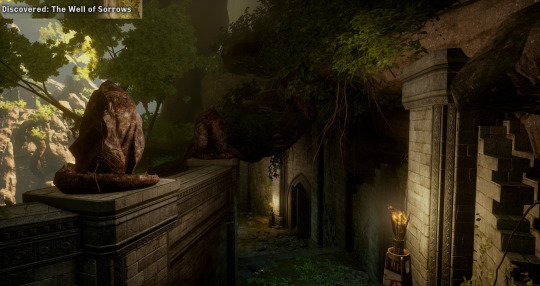


We finally reach an inner garden of the Temple which walls are decorated with more mural paintings: the standing elf, and several golden hallas. Some statues of the dragon Mythal are broken on the top of the wall. On the highest part of this garden, looming over the whole garden, we see a gargantuan statue of Humanoid Mythal. Probably the only statue with god-like dimension in all this Temple.

The Well of Sorrows is at the end of the path, on top of a big platform. As we reach it, Solas says “So Mythal endures”. Which is strange. Did he not know she was alive? Is this a line meaning he realises in this moment she is truly alive? Or part of this Well has a “will” of Mythal, so the existence of this artefacts means that Mythal still can exist? It’s curious his wording in this precise moment.

We learn from Samson that the Well contains wisdom/knowledge that would allow Corypheus have access to the Fade without even having the anchor. This is such a brutal lore-concept. The Vir’abelasan contains a power that allows to cross the Veil without any artefact.
If we talk to Calpeania [watch the video here] she seems to understand that the well has knowledge and power abandoned by the Evanuris [”The well of sorrows overflows with knowledge, power abandoned by those the elves worshipped as gods. To walk the Fade without the Anchor.”]

After getting rid of Samson or Calpenia, we see Abelas creating a stair of rift magic towards the well, ready to destroy it.
Depending on your respect to the Temple [meaning, you did the rituals at the entrance or you didn’t] we have different scenes in what follows:


Abelas has a duty: protect the well. If he can’t, he prefers to destroy it, losing all the wills/knowledge inside the water. This knowledge has been stored in this artefact over thousands of years, all servants of Myhtal have passed their knowledge and will to it when they head to Uthenera [once again, this has strong resemblances with the codex A Flowering Imago, explained in Ancient Elven codices; Vir Dirthara.

Solas encourages Abelas to stay in this world and perform another duty. Solas says “your people linger”, and then he confirms “Elvhen such as I”. Here is pretty clear the “People” that Abelas and Solas kept referring to: the Elvhen.
If the inquisitor asks for permission to drink from the well, Abelas says something that reinforces what he said: one doesn’t ask for permission to drink from the well, one has to work hard to get Mythal’s favour [“one obtains the right”]. So it is obviously implied that the Servants of Mythal were less than unwillingly slaves and more like willingly servants. However, I feel that this contradicts some mural paintings we saw along the Temple.
If the inquisitor asks for the price of drinking from the well, Abelas says “no boon of Mythal was ever granted without cost”, meaning that receiving a favour from Mythal is something you have to work hard to obtain, and there is always a price. I think this produce an extra indirect implication with Flemeth along the DA series: all the favours that Flemeth has been granting to several characters in books and previous games have a price that was never explicitly said, but it was implied in an obscure way.
Then, Abelas says something that called my attention: Anyone who drinks from the well is bound to the will of Mythal. In The Shrine of Dumat, and in the Attack of Haven, Corypheus made always an emphasis about being the “will of Corypheus”. This makes me suspect that Evanuris, and their “hard to kill” characteristic has to do with this “will”, a will that can jump into other bodies to survive.
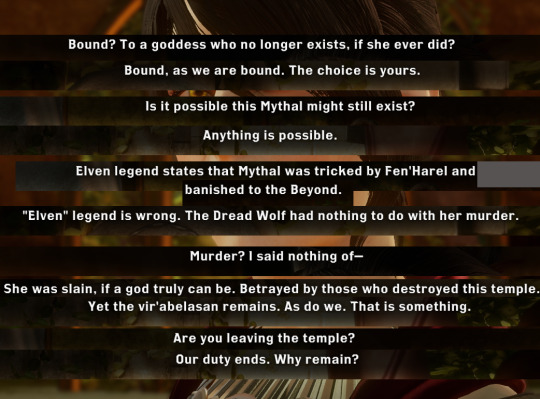
Morrigan mocks a bit the idea of being bound to someone who, in her opinion, doesn’t exist anymore.
Abelas and the rest of the servants of Mythal are bound to her. What this exactly means, it’s a bit more speculative since the game says little in an explicit way.
It’s surprising for me that Abelas, despite mourning the death of Mythal for ages, answers that anything is possible when asked if Mythal still exists. Did he meet Flemeth? Or Flemeth, since she is nothing more but a fragment, a shadow of what Mythal was, has changed, and preferred to never interact with these sentinels? The motherly goddess, abandoning her children because the world betrayed her and death changed her [we know via Solas’ words and Avvar’s codices in the DLC that all spirits return when killed but not in the same way. How much of this aspect of the spirits still remains in the Evanuris/Elvhen?]
Abelas, an elvhen who lived the time of the Evanuris, says that Dalish tales are wrong: The dread wolf had nothing to do with the death of Myhtal. Mythal was murdered.
Those who destroyed this temple were who killed her. [This bit of information is so vital yet we have nothing. In all the temple, what little we see destroyed, is mostly via Red Templars. But Abelas is referring to a very well known enemy by him. It’s not a modern enemy. When we enter to the chamber of petitions, he doesn’t know who Corypheus and his red templars are. So we can’t assume he is referring to them when he says this line. It’s a group of people form his past. In trespasser, Solas says that the last straw that motivated him to seal the Evanuris was the murder of Mythal. So, those who destroyed this temple had to be other Evanuris, but who? I can’t find any link. In the post Arbor Wilds: Temple of Mythal in detail I work on some potential hypothesis of these enemies, but there is no lead in-game.
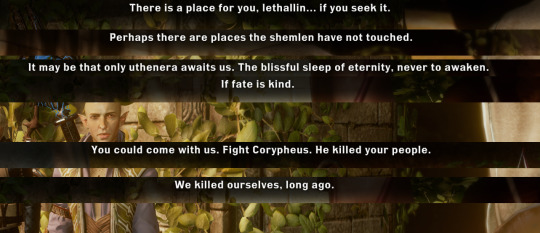
Solas invites Abelas to look for purpose elsewhere. I have the impression, and this is mere speculation, that Solas is recruiting him as an agent.
Here, Abelas speaks of Uthenera, and not mere slumber. Uthenera is something more definitive, to never come back.
He also reinforces the idea that the fall of the Elvhenan empire was exclusively Elvhen doing.

In this comment we can infer, in combination with the codex Unstranslable Writing from Ancient Elven codices, Temple of Mythal, that elvhen kept changing their name depending on their role. And this makes so much more sense if we keep in mind what Solas has been repeating to us for ages about the nature of the spirits: a spirit’s name is its purpose. And elvhens had a spirit-like nature. They are more vivid that the mere spirits we find in the Fade, which are described by Solas as “semi-existent”. Elves have always been more complex, fluid, and able to embrace more than one aspect than the spirits [this is also repeated by him several times when people question Myhtal’s duality of being fierce but also motherly]. That elves change their names as their purpose/duty is reshaped makes sense, it works similar to spirits: Wisdom spirits change their name to Pride when corrupted and their purpose is disfigured. And probably this change of name is vital, since acting against their purpose twist their nature.
On the other hand, if you showed a disrespectful behaviour towards the Temple, and Abelas is determined to prevent the spoil of the Well, we see an interesting cinematic [video here]
When Abelas is asked if he can claim that Mythal was a god, he seems to understand the truth of the Evanuris, since he says “to you... it shall make no difference.”
When Abelas attacks, we see the same kind of special effects that Mythal shows when she appears in the Altar [grey smoke, soft blue sparkles] and a blue glow inside his eyes [same as Flemeth when she commands the one who drank from the Well to stop Morrigan]
When he is destroying the well, the magical effect in his eyes makes me remember the old effect of the Archdemon, black, purplish fumes in eyes and breath [putting aside the differences of engines, of course]. Not because I want to relate Abelas to Archdemons, but because I wonder how close these powers are related to the Blight itself: a purified, non-corrupted version of them. We see similar ominous effect in Flemeth, and in the last seconds of the end of the Game, in Solas when he consumes Flemeth’s powers.
When Abelas dies, he says “Mythal Sulevin”. Sulevin is the elven word for “purpose”, as if he were saying: the goal of Mythal or the purpose of Mythal. What does this exactly mean? Has Flemeth planed this? We can ask her about how much she controlled the situations in her Temple and with the voices of the Well when we are in Flemeth’s Fade, and she praises the cleverness of the Inquisitor as an answer [see the post about Flemeth’s Fade]. So, Mythal has already told these elves to let the Well be consumed or destroyed? Or being killed by Flemeth’s chosen daughter was the real purpose of Abelas? Too vague.
Solas reacts to this unnecessary death, explaining: “he was defending all that was left of what once was.”
Once the well is consumed, there is similar effect around the drinker and the inquisitor [due to the Anchor, I imagine]: a smoky effect that Abelas had showed a moment before when trying to destroy the Well.
Curiously, it’s the same visual effect of Corypheus [hence my association with the old effect in the old engine of DAO in the Archdemons] It’s quite an ominous effect for magic related to the Fade.
Drink from the Well

Once Abelas is rid of, we have to decide what to do with the Well, learning some details in the process:
This well is the key for the activation of this Eluvian.
The well has a presence in itself, and something negative: a hunger, a compulsion.
Morrigan assumes that it’s the mere nature of knowledge: it begets a hunger for more.


Morrigan and Solas have a discussion. Solas asks for them to take the knowledge, but not giving it to Morrigan who represents, to his eyes, a person with too much ambition to trust this power.

If you offer the Well to Solas, he simply denies it, without any explanation and any chance to ask him again.
Morrigan suspects there is a remaining compulsion in the magic of the Well.

An Inquisitor with skill or knowledge in the arcane, can sense something else that Morrigan didn’t: the idea of “will” is reinforced again. And here is where I think the bound process and the wells are something that may be related to the codex A flowering Imago in Ancient Elven codices; Vir Dirthara: the whole persona, their will, is in this well, bound to Mythal forever, feeding a pond of memories and knowledge. It’s not just knowledge from the ancient elves. It’s their will, their “souls”. If we think that before the Veil elves were closer to spirits, these kind of Wells are aberrations: they bound their whole being to this pond.
The collective will of priests puts a compulsion in the person who drinks it. A geas. Corypheus knew about this [probably thanks to the orb] and for this reason he wanted a vessel [Samson or Calpenia]

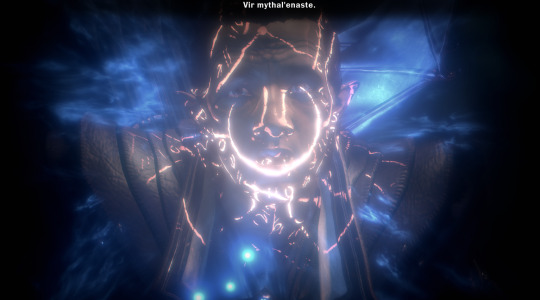
If the inquisitor drinks, we can see the procedure of the bound: inside the well, we hear the will of all those priests, I imagine. They know how to stop Corypheus, and mark the inquisitor with a standard overused snake-glyph that I showed in the post General glyphs and magical symbols. I think that speculations on this glyph have little to offer, the game has a limited amount of glyphs to give particular meaning to each of them.

As the inquisitor recover their consciousness, all the water has been consumed.


No matter who drank from the well, the inquisitor is surrounded by a dark smoke and blue reflections that make them glow. This kind of power is the same one we see in Abelas if he tries to destroy the Wll, or in Flemeth when she leave the Altar of Mythal. It’s the same effect that Solas has after consuming Flemeth’s essence at the end of the game.
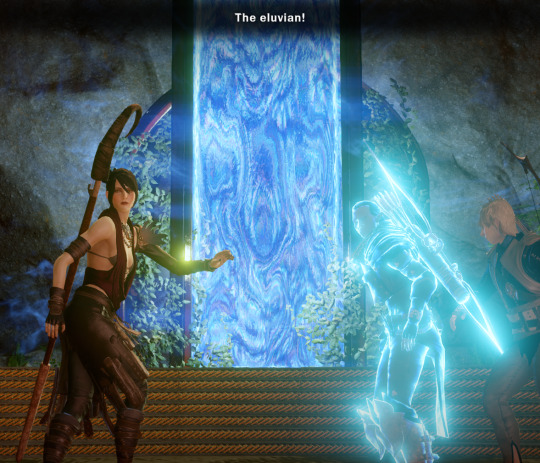
With the Well inside the inquisitor or Morrigan [the same scene can be seen no matter who drank it], we can activate the eluvian and escape Corypheus’ wrath.

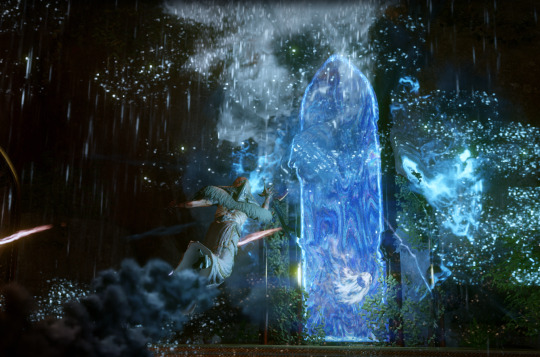
This is a scene that always was a mystery to me. I am not sure what happens here, but suddenly, the Well has water again and we see an entity raises from the water. It has the shape of a female human [rounded ears] and closes the eluvian behind her. This entity is one of the biggest mysteries to me. Nothing of what Abelas said, and all what we analysed before says anything about this creature. The only remote hint is that, if this Well had a piece of Mythal inside it, that piece could be shaped into a female human because Mythal merged herself with Flemeth’s soul and both are now a single entity [similar mash-up happens with Anders and Justice]. Honestly, I am not very convinced on this hypothesis, and it’s really hard to speculate what this human-spirit is.
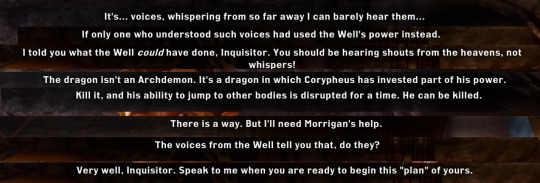
Returning to Skyhold, we discuss some details:
Because the Inquisitor was not as prepared as Samson, Calpenia or Morrigan were, they can’t use the knowledge of the Well properly. In fact, it’s quite useless for the rest of the game. This powerful tool should allow us to understand so much more lore, but still yet the devs were quite cowards in that sense. For the inquisitor works like a google translator of ancient elven, and nothing more, sadly.
Morrigan seems to make a better use of it, but we can’t know all what she learns from it.
We learn that Corypheus’ dragon is not an archdemon but a mere dragon where he put part of his power. If we kill the dragon, he can’t jump to other bodies. This is very retconned since in DA2 we don’t see any dragon, and yet Corypheus jumps to Janeka’s or Larius’ bodies anyways.
At the end of this quest, we can speak with Solas and analyse some vague bits of information he drops. These details will be posted in “Lore by Solas”.
Arbor Wilds: Temple of Myhtal - Part 1, Part 2, Part 3, Part 4, Part 5
#playing DA like an archaeologist#main quest#temple of mythal#well of sorrows#mythal#eluvian#abelas#elvhenan#elvhen
10 notes
·
View notes
Photo
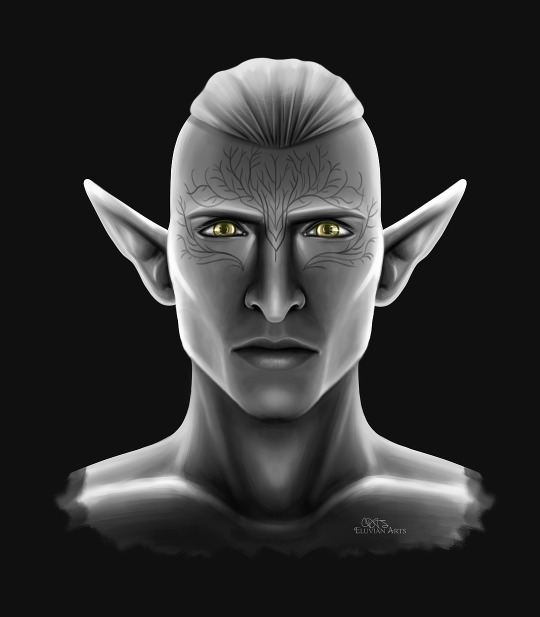
Men of Thedas bust sketches (8/?): Abelas
#Dragon Age#elf#Dragon Age Inquisition#Abelas#elvhen#elven#Mythal#vallaslin#Well of Sorrows#Vir abelasan#Temple of Mythal#fantasy art#fantasy artist#fantasy race#bone structure#anatomy practice#art practice#sketch#art sketch#digital art sketch
22 notes
·
View notes
Text
the wiki translates “Vir” as either “way” or “we”, meaning, “vir’abelasan” could also be translated to “we of the place of sorrows”
now, before I get to the second part of my theory, I have to mention that I've been working with a rather large web of theories concerning: the Evanuris' titles (because those aren't names), the importance of language (specifically in magic for this one), and the importance of 'true' names in magic (a trope I like).
and, we need to look at the Qun, too. Under the Qun, there are no names. Just titles. Because giving someone a name is synonymous with giving them an identity. The same, I wager, was true in Elvhenan. Because giving slaves an identity would be counterproductive to trying to keep your empire that relies on slavery up and running since people with a tangible sense of identity discover they don't like being oppressed.
which means, Abelas doesn't have a name. He has a title, a job, a duty. His whole life's purpose is to protect the Well. He was most likely raised and trained for that alone, with no other ambitions or goals in his mind.
with that in mind, Solas' last words to Abelas ("I hope you find a new name" or something, I believe) make much more sense to me, if 'finding a name' means 'finding an identity outside of slavery'.
#dragon age meta#well of sorrows#abelas#elvhen#i have a very elaborate theory regarding language / names / and their importance#I might write a post about it eventually
24 notes
·
View notes
Photo



Well of Sorrows
13 notes
·
View notes
Text
Drinking Mythal's hot bathwater.
#when i played this before i didnt have cole#so im used to seeing solas in coles spot#its a bit off to me#bc solas is the one talking to deshan#deshan lavellan#temple of mythal#mythal's bathwater#well of sorrows
4 notes
·
View notes
Text
Thinking about Theresa Trevelyan post-Trespasser, searching for a way to break the geas from the Well of Sorrows, and the fact that she not only has ancient Elvhen knowledge locked away in her mind, slowly guiding her almost subconsciously and sometimes openly. It reminds me of John Crichton and the wormhole knowledge implanted into his subconscious by the Ancients, meant not as an answer but as a guide. Wondering if it works in similar ways with the whispers from the Well.
#theresa trevelyan#duchess musings#da meta thoughts#dai meta#well of sorrows#farscape#farscape wormholes
3 notes
·
View notes
Photo

Tel abelas...
The inquisitor and co are hiding in monstera and waiting for Sentinels and Venatori to kill each other :-) T- Tactics ♟
I hope I have the strength and patience to finish this.
And yes Calpernia is the best here :D
#dragon age#dragonage#Dragon Age fanart#DAInquisition#dai#ancient elven inquisitor#inquisitor lavellan#Lavellan#Iron Bull#Cole#Solas#Well of Sorrows
10 notes
·
View notes
Photo
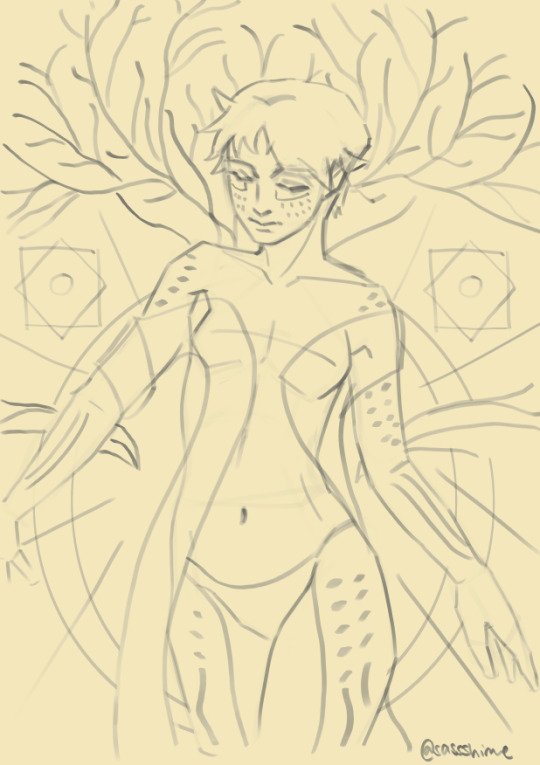
Inquisitor Ellana Lavellan, First to the Keeper, Servant of Mythal
#sassshime art#my art#inspired by the official elf tarot card#and drinking from the well lmao#digital sketch#dragon age inquisition#fanart#elf oc#lavellan#solavellan#dragon age#dalish#female inquisitor#ellana lavellan#inquisitor lavellan#mythal#well of sorrows
15 notes
·
View notes
Text

Never drink water from dubious wells
6 notes
·
View notes
Text
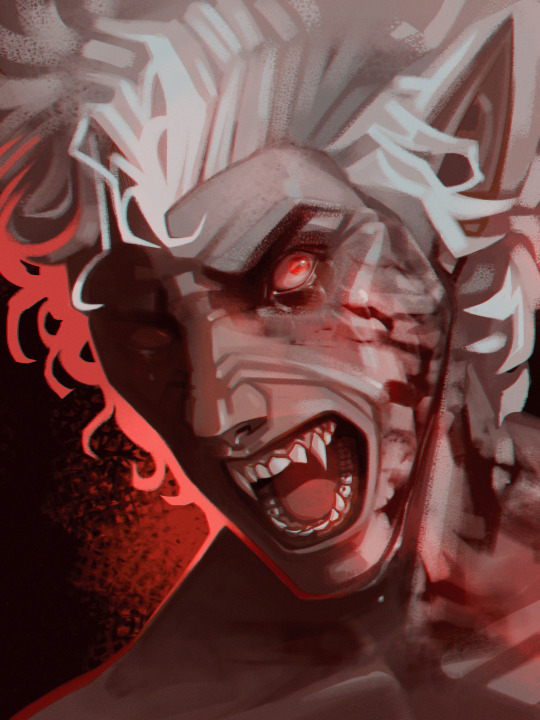
rage.
#welcome to today's episode of “me trying to draw 76 different emotions at once”#rage+grief???sorrow??? anguish?????#hmmmmmmm#definitely pain#and a hint of fear#no but like he's angry but there's sadness underneath you get what i'm saying#the kind of rage caused by something that left you traumatized and you just can't stop thinking about how unfair it was#like “i didn't deserve this nobody deserves this” kind of rage#well anyway#i don't even care about anatomy at this point#just let me see how much i can distort the face and still have it somewhat resemble the character#didn't mean to draw him crying again but my hand slipped oops#astarion#bg3#baldur's gate 3#bg3 astarion#baldurs gate 3#astarion fanart
6K notes
·
View notes
Text
Murals of DAI: Removal of the Vallaslin
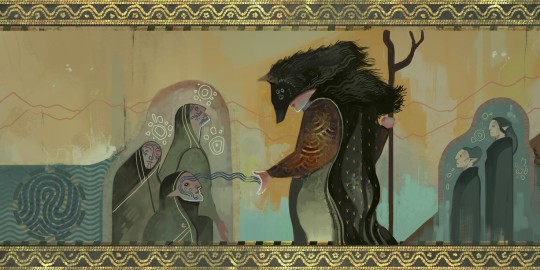
This mural is located in Elven Mountain Ruins , Forgotten Sanctuary.
[This post is part of the series “ Murals of DAI ”]
[Index page of Dragon Age Lore]
Let’s see the details first:
The background

It’s easy to see that the background depicts in a simple way, without stealing focus from the main figures, the valley of Elven Mountain Ruins.
The top and bottom of the mural show a dashed line [golden and black] that we have seen in previous murals and art from the books of World of Thedas as the most commonly used symbol to represent the Veil [Check Murals in DAI: Basics]. However, we know that during this time the Veil did not exist yet. So I will understand it as a “generic barrier”. Maybe the presence that there are two lines, up and down, framing the whole mural, represent that this space [the valley] exists inside “a pocket” in between the worlds and this barrier contains this space.
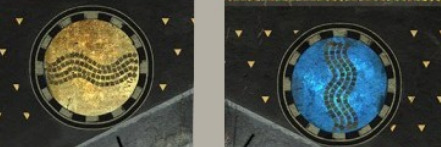
This would make a bit of more sense if we interpret this “pocket” as "a world in a sphere”, like the spheres surrounded by the same kind of line in the Mural of “The Creation of the Veil”. Maybe this is implying that this type of barrier allows you to create space pockets in a similar way as we saw it in the codex Raising the Sonallium.
The top line has some parts faded, the bottom line is very well conserved. The elves and the pool of water are over the line, maybe as a representation that they are inside of this pocket place, while the "priest" exists inside and outside of this pocket world.
The water pool
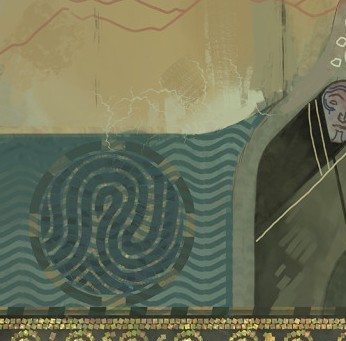
The water is drawn with undulating lines. This could be interpreted as mere “water” [we usually draw it this way] but also could mean a kind of Water similar to The Well of Sorrow’s, where those who drink from it become bound to it. Undulating lines have been used in many others mosaics and murals as a symbol of slavery related to the brand of the Vallaslin [for more details, read Ancient Elven codices; Fen’Harel’s mountain ruins and Murals in DAI: Basics] Even in the current mural we can see that the Vallaslin that is removed from the elf is depicted with undulating lines.
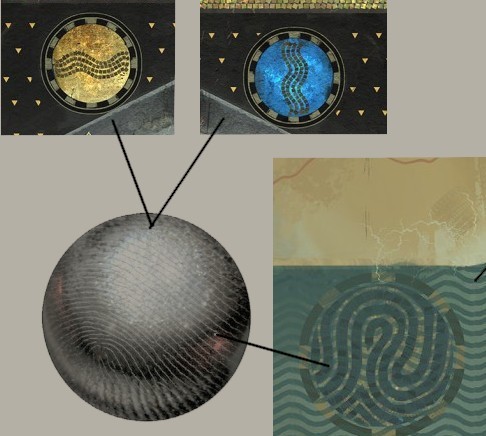
Now, submerged in the water we find the undeniable shape of an elven orb. Curiously, in all murals where we find the elven orb, we see it surrounded by the same line that represents the Veil [see Murals in DAI: Basics for the details].
The emerging Elves
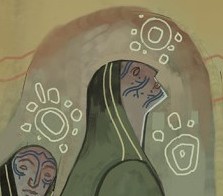
The elves wear moss-green robes. Solas wears similar green in most of his murals.
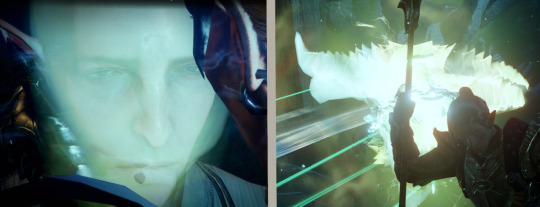
Green is a colour we see for the Fade-related entities. It’s not the typical orange one of the wraiths. Green has been used [in brighter versions] in Solas and in the dragon bound to Hakkon, suggesting entities similar to spirits bound to a physical form. As an addition, these robes have white lines that stand out and surround the elves’ branded faces. The free elves don’t have them. These details makes me think that they may represent that these elves are spirits bound to flesh and lines have a strong symbolic meaning to bound processes.
Their skin colour is more pinkish than the free elves too, maybe as a way to emphasise from a design point of view the idea that they were more “fleshy” and less “spiritual”.

One of them in particular has a mirrored six that got my attention from other statues: I only found mirrored versions of this strange subtle symbol in two other places:

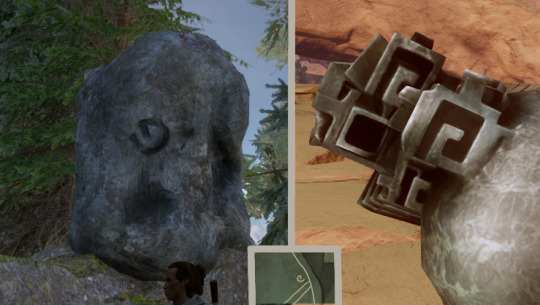
In the back of an Eroded dragon skull, or on the elvhen artefacts used to strengthen the Veil.
We know that the artefact works as intended. Solas is not making us activate a super shady system to destroy the world. That thinking makes no sense: he knows he will destroy the Veil eventually, but until then, he wants the rest of the inhabitants of Thedas to live in peace and comfort. If this is a symbol that helps to reinforce the connection with the Veil, and this was used in a mural even before the creation of the Veil, it may be a symbol that would suggest a reinforcement of reality or shape. When I say it like this, it sounds a bit Titan-like. On the other hand, the elvhen artefact always looked Dwarven to me. That same symbol that appears in the green robe as well as in the elven artefact is a decorative pattern you can find in rugs and beds of underground dwarven buildings. So, finding that strange link makes my suspicion a bit stronger. Now, what’s the purpose of the Eroded dragon skull? That’s beyond me, specially because the game never explained the function of these statues. All what we know is that it’s Avvar.
Each of the elves has a strange white bubble floating over them, with small ones around. It’s impossible for me to understand this. In some way, they look like the strange symbols that appeared around the eyes of the hallas or dragon in the Nation Art: Elvhen.

But they are not quite like it. I’m clueless here. The most metaphorical interpretation I can develop, based on lore, is that those white bubbles may represent the voices of the corresponding Well, in similar fashion that the Well of Sorrow whispers into the head of those who drank from it. But this interpretation would mean that the free elves still can hear some voices, since those bubbles persist, but some are more opaque than others.
Fen’Harel
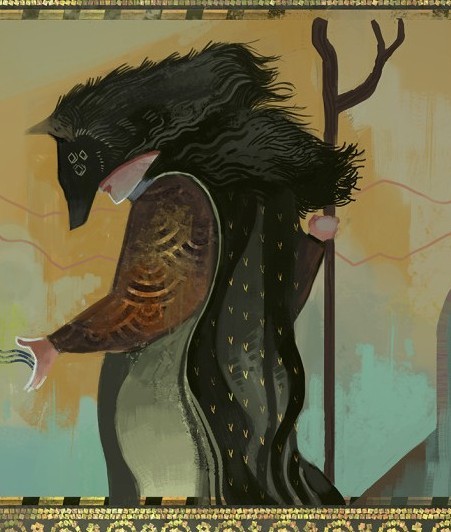
Fen’Harel is presented as a person wearing a wolf cape and a fine robe. The intricate patterns of the fabric makes him look more important, more “Evanuris”. This is one of the many reasons I wonder if he truly painted this mural, since he usually draws himself with the same kind of robes than the slaves are wearing: a black and green simple robe. I think there is an intent of idealisation of Fen’Harel by making his outfit fancy and more elaborated.
The figure is covering his face with a wolf mask, so, technically, anyone can take this role. The mask has 3 eyes, six in total. To me, this figure represents, ironically, a “priest” of Fen’Harel, a representative that embodies Fen’Harel’s (romanticised) ideas and shares and applies the power that Fen’Harel himself gave them [aka, the spell to remove the Vallaslin]. We saw the removal of the Vallaslin in the romance scene of Solas: it’s a mere spell that doesn’t need any great material or ritual to be performed, it’s easy and doable if you know the spell.
The staff looks like a regular branch. We know that his staff from his tarot card is a kind of a “halla profile” with a very messy set of horns. In this mural we see something quite more generic. For all these details is that I assumed that there is a probability that this mural was not painted by Solas, but there are no conclusive proofs.

As a colourful note, more from an artist point of view, the mantle that Fen’Harel is wearing here has the same design that the robe worn by Calpernia. Both drawings were done by Nick Thornborrow, so maybe there is an implicit symbol in it, something like “the mantle of the mage leader” or, if we think in Calpernia, “former slave turned into mage leader”. But this would be relating, only through the art pieces, two lore unrelated characters just to give meaning to a pattern that both wear, so I’m sceptical about this.
Free elves
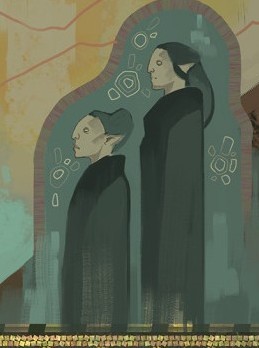
The free elves have no lines on their robes nor in their faces, unlike the emerging elves. However, they look a bit more paler and smaller. I’m not sure if we can consider them with hair [with the exception of Felassan, most of the elvhen we saw were bald, no matter the gender]. The bubbles around them are similar to the branded elves, but not all lines stand out, only some. If the only meaning I could scratch about these bubble is correct, it would imply that the free elves may still listen some whispers [again, I’m not convinced at all about this interpretation].
Extra details

For some unknown and unsettling reason, this mural has the face of the The Strange Idol repeated four times, with its mouth stained in (dry, I assume) blood. We have seen this exact circle with his face in Emerald Graves: Din'an Hanin and in Emerald Graves: Din'an Hanin, Elandrin’s Tomb. One of these heads holds the brazier from where you can cast Veilfire.
Does this have any meaning? I’m not sure. We are not sure who this figure represents yet. The furthest we reached was Elgar’nan, thanks to the description in Signs of Victory as I commented in Ancient Elven codices; Vir Dirthara and thanks to the name of the zone [Elgar’nan’s bastion] where we find his statue in the middle of Elandrin’s Tomb. But we don’t know who named this place like that, so we don’t have anything truly reliable to identify this statue. So far, we can only suspect it to represent Elgar’nan, while some Tevinters considered it Dumat. More details about this unsettling figure can be read in The Strange Idol.
Integral Interpretation
The elves that come out from the water, branded, are slaves or servants. We know this only by the presence of the blue Vallaslins on their faces [ which is potentially associated with lyrium]. The process may keep them bound to a Well similar to the Well of Sorrow, and they may hear voices that serve [and probably are even controlled by] the Evanuris/noble they are bound to [we know this by playing the Inquisitor who drank from the Well and talked to Flemeth; more details in Altar of Mythal]. Maybe these whispers are represented in the white, deformed bubbles over the figures [I’m very doubtful about this interpretation, though].
This mural would allow us to reinforce the idea that pools of this nature are created or fed by the elven orbs [thus it's submerged in it].
The elves that want to get free from the bound look for Fen'Harel, potentially represented by a free mage who embodies the romanticised ideas of Fen’Harel, and trough Solas’ spell, removes their Vallaslin. It’s not clear if this figure is Solas himself or may be a representation of him, performed by “priests” of Fen’Harel.
The free elves seem to have changed of shape: they are paler, a bit yellowish, and smaller. We suspect from the last mosaic of Ancient Elven codices; Fen’Harel’s mountain ruins that this process may have caused some change in the physiognomy of the free elves. The white bubbles are still around them but not so opaque, implying [if this interpretation is correct] that they may keep hearing the voices of the Well, but less intensely. The lower body of the free elves has been filled with little paint, giving the idea that they are floating or have no feet, suggesting a return to their spirit-like nature.
The detail I can’t interpret at all is the deformed brownish bubble that surrounds the three branded elves, and the blue one with a brownish border that wraps the free elves. And, of course, the presence of the face of The Strange Idol.
As I always say, all these interpretations are approximations, speculations, and attempts to understand the lore we see in the murals. Some ideas, due to their repetition in other pieces of art, give us more confidence in their suspected meanings, while others are just the most Occam’s razor speculation I can create.
#DAI murals#High speculation#elven orb#well of sorrows#well#pool#fen'harel#the strange idol#strange idol#lyrium#undulating#vallaslin
6 notes
·
View notes